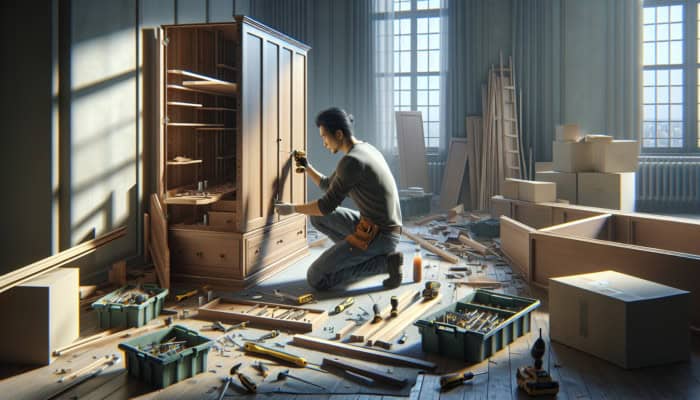Strategically Planning Your Furniture Clearance
Thoroughly Assessing Your Available Space

Determining which pieces of furniture require removal goes beyond mere aesthetics; it involves a comprehensive assessment of furniture removal methods for clearance. Begin by meticulously evaluating each room within your home or office, identifying items that no longer serve a purpose or that clash with your current decor. Carefully consider the layout of each area: are there bulky pieces that congest the space and hinder movement? Step back and visualise how every item contributes to the room’s functionality. This evaluation should encompass the current use of each piece and your future requirements. By fully comprehending each item’s role, you can make informed choices about what to retain and what can be eliminated from your space.
Moreover, it’s important to reflect on any emotional connections you might have with certain pieces of furniture. While it may be challenging to part with sentimental items, ask yourself whether they genuinely enhance your living or working environment. Taking photographs of the furniture slated for removal can serve as a means to preserve those memories without the necessity of keeping the physical items. After completing your evaluations, compile a clear list of all items marked for removal. This list will be invaluable as a practical guide throughout the clearance process, ensuring nothing is missed or overlooked.
Creating a Realistic Timeline for Your Clearance
Establishing a comprehensive timeline for your furniture removal ensures a smooth and efficient process. Begin by considering any impending deadlines you may be facing, such as moving into a new residence or needing the space cleared for renovations. Break down the clearance into manageable phases, allocating specific days or weeks for various tasks. For instance, you might designate one weekend for disassembling large items and another for transporting them away. It’s also crucial to account for potential delays, such as waiting for a removal service or requiring additional time to prepare your space.
A structured timeline keeps you organised and instils a sense of urgency that encourages you to follow through with your plans. Communicate this timeline clearly to any family members or helpers involved, ensuring everyone is aligned and on the same page. Utilise digital tools or apps designed to assist in tracking your progress, allowing you to adjust your schedule if necessary. A well-planned timeline reduces stress and guarantees that your furniture removal methods for clearance are carried out efficiently and on time.
Establishing a Budget for Your Furniture Removal
Creating a detailed budget for your furniture removal is a vital step to prevent unexpected financial surprises later on. Start by contemplating all potential costs involved in the process. If you intend to hire a removal service, research local options and request quotes to gauge the average pricing in your area. Don’t overlook the costs of renting transport vehicles, purchasing packing materials, or even disposal fees at local waste facilities. If you prefer a DIY approach, factor in expenses for equipment rentals, such as dollies or packing supplies, which can accumulate if not adequately planned.
Once you have compiled a comprehensive list of all potential costs, compare it against your overall budget for the clearance. This analysis lets you pinpoint areas where you might need to reduce expenses or identify alternative solutions. For example, if hiring a removal company exceeds your budget constraints, consider contacting friends or family for assistance. Effective budgeting isn’t merely about limiting costs; it’s also about ensuring you allocate funds for unexpected contingencies that may arise. By formulating a thorough financial plan, you can sidestep the emotional stress of overspending during removal.
Selecting the Right Removal Company for Your Needs

Conducting thorough research is essential when selecting a reputable furniture removal company that meets your needs and budget requirements. Start by compiling a list of potential services available in your local area. Look for companies that specialise in furniture removal methods for clearance, as their expertise will ensure your items are handled with care. Online reviews and testimonials from previous customers can provide invaluable insights into the reliability and quality of a service, helping you make an informed choice.
As you evaluate various companies, don’t hesitate to ask for references or case studies of their past work. This approach will give you a clearer understanding of their professionalism and operational efficiency. Once you’ve narrowed your selections, request detailed quotes and clarify what services are included in the pricing. Are they responsible for packing, disassembling, and transporting your furniture? Understanding the scope of their services can significantly impact your overall budget and timeline. Ultimately, choosing the right removal company will ease the burden of the clearance process and ensure that your items are treated with the utmost care and respect.
Essential Preparations for the Clearance Day
Preparation is the cornerstone of a successful furniture clearance. On the day designated for removal, ensure you have all necessary tools readily available. This may include screwdrivers for disassembling furniture, blankets for protecting items during transport, and packing tape for securing boxes. Consider enlisting the assistance of friends or family members to help with heavy lifting; this expedites the process and makes it more manageable for everyone involved.
Moreover, ensuring clear access to the items you plan to remove is crucial. Remove any obstacles that could hinder the removal process, such as smaller furniture pieces or decorative items that might get in the way. If your furniture is on a higher floor in an apartment building, check that the lift is operational or be prepared to navigate the stairs. Clear communication with your removal team is vital; provide specific instructions regarding which items should be taken and where they should be placed during transport to ensure a smooth operation.
Exploring DIY Furniture Removal Options
Expertly Disassembling Your Furniture

Disassembling larger pieces of furniture can significantly ease the process of furniture removal methods for clearance. Many heavy items, such as beds and wardrobes, can be cumbersome. By taking them apart, you facilitate easier transport and mitigate the risk of damaging your property and the furniture. Gather the necessary tools, including screwdrivers, wrenches, and hammers. Familiarise yourself with the assembly instructions, if available, to avoid confusion during the disassembly process.
As you disassemble each piece, take care to label screws and components in separate bags. This practice simplifies reassembly should you decide to keep any furniture or resell it in the future. Documenting the disassembly process with photographs can prove beneficial, particularly for those inexperienced in reassembling furniture. This method provides a visual reference for how everything fits together, making the eventual reassembly considerably easier.
Renting a Van for Your DIY Removal
For those opting for a DIY approach to furniture removal, renting an appropriate van is often necessary. Consider the size of the furniture you’re moving and ensure that the vehicle you select can comfortably accommodate everything. Many rental companies offer various sizes of vans, so choosing one that aligns with your specific requirements is crucial. Conduct thorough online research to identify the best rental rates in your area, and consider booking in advance to secure the vehicle for your desired dates.
Before picking up the van, please verify that you possess a valid driving license and are familiar with its features. Take a moment to inspect the van for any existing damage, ensuring that these are documented before you drive away. Pack your furniture carefully once you have the van, securing each item to prevent movement during transit. Blankets and straps can help protect your furniture and the vehicle itself. Remember that efficiently loading and unloading the van can save you considerable time throughout removal.
Prioritising Safety Precautions During Removal
Safety should always be your top priority during any furniture removal process. Lifting heavy objects without employing proper techniques can lead to serious injuries, making it vital to use your legs instead of your back when lifting items. Additionally, don’t hesitate to ask for help if a piece feels too heavy to manage independently. Protective gear, such as gloves and sturdy footwear, is also advisable to safeguard against accidents or injuries.
Ensure you have a clear understanding of your surroundings. If you’re moving furniture through narrow hallways or doorways, take extra precautions to avoid damaging the walls or the furniture itself. Communication is key when working with others; inform your helpers of any obstacles or plan the lifting process. By prioritising safety, you’ll protect yourself and others and ensure your furniture removal goes off without a hitch.
Engaging Professional Services for Your Removal
Finding the Right Removal Company
When hiring a professional furniture removal company, the significance of thorough research cannot be overstated. Begin by seeking companies that have established a solid reputation within your community. Online reviews can offer valuable insights into previous customer experiences, highlighting strengths and weaknesses of various services. Pay particular attention to recurring themes or issues mentioned in reviews—this can provide a clearer understanding of the quality of service you can expect.
Additionally, it’s wise to seek recommendations from friends or family who have undergone similar removal processes. Personal experiences can point you towards reliable companies that may not be as visible online. Once you have compiled a shortlist, contact each company for tailored quotes. Be specific regarding the type and amount of furniture requiring removal, as this can significantly impact pricing. When you have gathered quotes, don’t opt for the lowest offer; consider the services included and the company’s overall reputation to make a well-informed decision.
Gaining Clarity on Service Costs
Understanding the pricing structure of furniture removal services is crucial to avoiding unexpected costs. Different companies offer varying pricing models, often influenced by factors such as distance, volume of furniture, and additional services like packing and unpacking. Request detailed quotes that outline precisely what is included in the price. For instance, does the quote cover the disassembly of large items? Are there additional charges for moving items up or down stairs?
Be vigilant about hidden fees, such as fuel surcharges or disposal charges. Clarifying these details upfront ensures you aren’t caught off guard later. Some companies may offer flat rates, while others charge by the hour. If the latter is applicable, consider the crew’s efficiency; a quicker job may save you money in the long run. Taking the time to thoroughly understand the service costs will enable you to maximise your budget and ensure a seamless removal process.
Preparing Your Space for Professional Services
Preparing your space for professional furniture removal can significantly streamline the entire process. Before the removal crew arrives, clear pathways and remove any obstructions. This preparation facilitates a swift assessment of the situation by the team, allowing them to get to work without unnecessary delays. An organised space fosters efficiency and minimises the risk of accidental damage to your property or the items being removed.
Furthermore, labelling items according to their designated destinations is beneficial, whether a van for donation, a recycling centre, or direct disposal. Communicate clearly with the removal team regarding any specific instructions you may have, such as which items are particularly fragile or which you’d like to retain. By taking these proactive steps, you can ensure that your furniture removal proceeds as smoothly as possible, enabling the professionals to work efficiently and effectively.
Exploring Eco-Friendly Disposal Options
Donating Usable Furniture to Benefit Others
Consider contributing to your community by donating usable furniture as part of your clearance process. Numerous charities and local organisations eagerly accept good-quality items, from sofas to tables. Not only does this practice assist those in need, but it also significantly reduces landfill waste, creating a mutually beneficial situation—research local charities to determine which items they accept and arrange for pickup or drop-off as necessary.
When donating, ensure that the furniture is clean and devoid of damage, as many organisations impose strict guidelines concerning the condition of items they can accept. Some charities even provide tax deductions for donated goods, offering an additional financial incentive. Furthermore, this generosity can foster a sense of community connection and provide personal satisfaction, knowing you have positively impacted another person’s life.
Recycling Furniture Materials Responsibly
For furniture that is no longer usable, recycling presents an eco-conscious choice that aligns with sustainable practices. Many furniture components, such as wood, metal, and fabric, can be recycled rather than end up in a landfill. Before proceeding with disposal, check local recycling facilities that accept furniture materials. Investigating these options can unveil a range of sustainable disposal methods that resonate with your values.
Disassembling items before recycling can help separate materials for easier processing. Many community recycling programs offer drop-off locations or curbside collection services for larger items. Engaging with these services diminishes waste and promotes a circular economy by repurposing materials. Understanding your local recycling options is critical in adopting environmentally friendly furniture removal methods for clearance.
Embracing Upcycling Projects for Creative Solutions
Upcycling offers a creative outlet for individuals seeking to breathe new life into old furniture while minimising waste. This process entails transforming unwanted items into new, functional pieces, creating an engaging and environmentally friendly endeavour. For instance, an old dresser can be repurposed into a stylish TV stand, or a coffee table can be revitalised into a chic bench.
Before embarking on your upcycling project, consider what modifications will enhance the furniture’s functionality or aesthetic appeal. This may involve painting, reupholstering, or even reconfiguring pieces for different uses. Not only does this practice minimise landfill contributions, but it also presents a unique opportunity to express your style and creativity. Sharing your upcycled projects on social media can inspire others to think beyond traditional furniture disposal, encouraging them to embrace innovative solutions.
Composting Organic Materials for Sustainable Disposal
Composting can be an excellent disposal option for individuals dealing with furniture made from natural materials. Items like wooden furniture or textiles crafted from natural fibres can often be broken down into compost. This method enriches the soil, contributing to a healthier environment while reducing waste.
Before composting, ensure the materials are free from chemicals or synthetic treatments, as these can harm ecosystems. Breaking down furniture into smaller pieces can facilitate the composting process. Moreover, this eco-friendly option aligns with a growing awareness of sustainability, encouraging individuals to consider the life cycle of their possessions. By adopting composting as a viable disposal method, you contribute positively to the environment while responsibly clearing your space.
Maximising Profit by Selling Unwanted Furniture
Utilising Online Marketplaces for Sales
Selling unwanted furniture through online marketplaces can effectively declutter your space while generating extra cash. Platforms such as eBay, Gumtree, and Facebook Marketplace allow you to reach a broad audience, enhancing the likelihood of a successful sale. Begin by taking high-quality photographs of your items, ensuring you capture their best angles and unique features to attract potential buyers.
When listing your furniture, be descriptive and honest about its condition. Include dimensions, material types, and any notable wear or damage. Setting a competitive price is crucial; research similar listings to ensure your item is attractively priced. Engage with potential buyers promptly to answer questions and arrange viewings. Successfully selling your furniture helps declutter your space and provides others with affordable options for quality items.
Organising a Garage Sale for Local Sales
Hosting a garage sale represents another effective avenue for selling unwanted furniture while connecting with your local community. This method allows you to showcase multiple items simultaneously, attracting potential buyers who appreciate the convenience of browsing through various pieces. Promote your garage sale through social media, local community boards, and flyers to maximise your reach and attract a broader audience.
On the day of the sale, arrange your furniture logically and ensure items are easily accessible to potential buyers. Consider offering bundled deals for multiple purchases to increase sales volume and attract interest. Be prepared to negotiate with buyers, as this is a natural part of the garage sale process. Hosting a garage sale clears your space and creates a fun and social atmosphere within your community.
Collaborating with Consignment Shops for Sales
Partnering with consignment shops can be a savvy strategy for selling unwanted furniture. These businesses will sell your items on your behalf, taking a percentage of the sale price as their fee. Start by researching local consignment stores specialising in furniture, and reach out to understand their acceptance criteria and commission structures.
When working with consignment shops, ensure that your items are in excellent condition, as many shops impose strict guidelines regarding the quality they will accept. Appealingly displaying your furniture can help attract interest and expedite sales. While this method may take longer than selling directly, it alleviates you from the hassle of managing individual sales and can often yield better prices for your items.
Understanding Legal and Safety Considerations
Familiarising Yourself with Local Regulations
Understanding local regulations regarding furniture disposal is crucial to avoid potential fines or legal complications. Different municipalities have varying rules concerning the disposal of large items, and some may require specific permits for bulk waste removal. Before proceeding with your clearance, please consult with your local council or waste management authority to ensure compliance with their guidelines.
Some areas have designated bulk waste collection days when residents can leave large items at the curb for pickup. Familiarising yourself with these schedules can save time and effort, making the disposal process more efficient. Additionally, be aware of any recycling programmes that may offer incentives for responsible disposal. Adhering to local regulations ensures legal compliance and reflects your commitment to sustainable practices in your community.
Implementing Proper Disposal Methods
Adopting approved methods for disposing of furniture is essential for protecting the environment and promoting sustainability. Many traditional disposal methods discard items into landfills, contributing to the escalating waste crisis. Instead, consider alternatives such as recycling, donating, or using designated collection services prioritising eco-friendly disposal practices.
Conduct thorough research on local disposal facilities that accept furniture and investigate what materials they recycle. Many areas have specialised centres for hazardous materials, making it crucial to responsibly dispose of items like treated wood or upholstered furniture. By utilising proper disposal methods, you contribute to a more sustainable environment while ensuring that your furniture removal methods for clearance adhere to best practices.
Ensuring Adequate Insurance Coverage
Verifying your insurance coverage before removing furniture is often an overlooked yet critical step. Many homeowners’ or renters’ insurance policies may cover damages incurred during removal, but the specifics can vary widely. Before scheduling any removal, check with your insurance provider to clarify what is covered and under what conditions.
If you hire a professional removal service, confirm whether they carry liability insurance. This coverage protects you should any damages occur during removal, ensuring your peace of mind. Obtaining proof of insurance from the company you hire is advisable, guaranteeing that you are protected throughout the clearance. Understanding your insurance coverage guarantees and safeguards your assets during a potentially risky undertaking.
Utilising Safety Equipment Effectively
Utilising appropriate safety equipment during furniture removal can significantly minimise the risk of injury. Essential items include gloves, sturdy footwear, and, if necessary, protective eyewear. For larger or more awkwardly shaped items, consider employing lifting straps or harnesses designed to help distribute weight and alleviate strain on your back.
Moreover, ensure that anyone assisting in the removal process is equally equipped with safety gear. Discuss safety protocols beforehand, including proper lifting techniques and clear communication during the lifting and transporting items. By prioritising safety equipment and practices, you protect yourself and your helpers while facilitating a smooth and efficient clearance process.
Frequently Asked Questions About Furniture Removal
What are the most effective furniture removal methods for clearance?
The most effective methods include DIY clearance, hiring professional services, donating usable items, recycling materials, or selling unwanted furniture through online platforms or garage sales.
How can I prepare for a successful furniture clearance day?
Prepare by thoroughly assessing your space, disassembling large items, clearing pathways, and gathering all necessary tools. Communicate clearly with helpers or removal services about specific instructions to ensure a smooth process.
Are there eco-friendly options available for furniture disposal?
Yes, eco-friendly options include donating usable furniture, recycling materials, upcycling, and composting organic items like wood and natural fabrics to reduce waste.
How can I identify a reputable furniture removal company?
Research local companies by examining online reviews and seeking recommendations from friends or family. Request quotes and compare their services and pricing structures before making an informed decision.
What should I do with furniture that is in poor condition?
Furniture in poor condition can be recycled or, if feasible, taken to a landfill. Check local regulations for specific disposal guidelines and options in your area.
What strategies can I use to sell unwanted furniture effectively?
Sell unwanted furniture through online marketplaces, host a garage sale, or partner with consignment shops. Ensure all items are in good condition and take high-quality photographs for your listings to attract buyers.
What legal considerations should I be aware of regarding furniture disposal?
Local regulations vary; check with your municipality regarding bulk waste disposal rules and permitted collection methods to avoid potential fines or legal issues.
What safety equipment should I utilise when removing furniture?
Utilise gloves, sturdy footwear, and protective eyewear. Consider lifting straps for heavier items to prevent injury and ensure safe handling.
Can I donate furniture that is in any condition?
Most charities prefer items in good, usable condition. Before donating your furniture, check with local charities to understand their specific acceptance criteria.
What costs should I anticipate when hiring a removal service?
Costs may include service fees, disposal fees, and potential extra charges for specific items or distances. Always ask for detailed quotes to understand the pricing structure fully.






